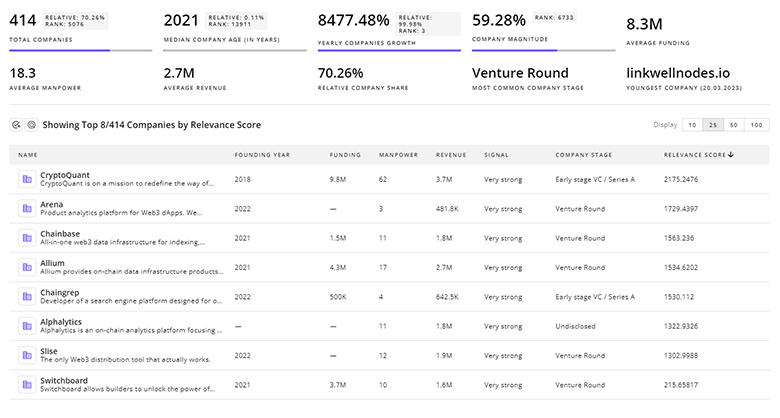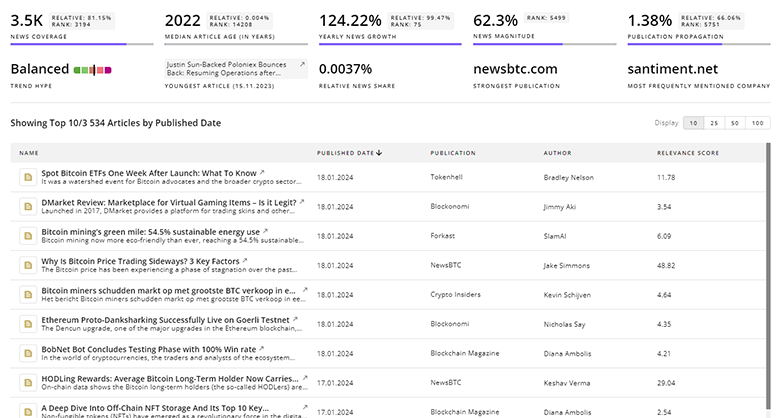
Energy Storage Report
: Analysis on the Market, Trends, and TechnologiesThe energy storage market is at scale: the internal trend data places 2024 market size at $668.7 billion and projects a 21.7% CAGR, signaling aggressive commercial expansion and investment appetite. Capacity and project-level signals from independent market research complement this dollar growth—installed storage demand was 222.8 GW in 2022 with forecasts to exceed 512.4 GW by 2030, illustrating that monetary growth is tracking meaningful gigawatt additions rather than only price effects. This combination—large market value, high CAGR in internal data, and rising installed capacity—makes energy storage a decisive system-level lever for grids, commercial sites, and distributed assets over the next decade.
This article was last updated 20 days ago. If you find any info is missing, let us know!
Topic Dominance Index of Energy Storage
The Dominance Index of Energy Storage looks at the evolution of the sector through a combination of multiple data sources. We analyze the distribution of news articles that mention Energy Storage, the timeline of newly founded companies working in this sector, and the share of voice within the global search data
Key Activities and Applications
- Grid-scale firming and multi-hour dispatch: large front-of-meter projects supply time-shifted energy to replace gas peaker plants and support high renewable penetration BNEF.
- Long-duration energy storage for seasonal and day-to-day gaps: 8+ hour systems (flow, iron-air, thermal, CAES) address hours-to-days shortfall that four-hour lithium stacks cannot cover cost-effectively.
- Distributed and behind-the-meter (BTM) services: C&I and residential storage reduce demand charges, enable resilience, and participate in virtual power plants and demand-response markets.
- Second-life EV battery reuse and circular supply models: repurposing EV packs into stationary BESS lowers upfront cost and shortens project lead times while mitigating raw-material exposure Moment Energy.
- Ancillary/grid services and fast frequency response: high-power, fast-response systems (supercapacitors, flywheels, advanced BESS) deliver frequency regulation and sub-second grid services that monetize stacked value streams Amber Kinetics.
Emergent Trends and Core Insights
- Diverging metrics: dollar market and installed-capacity forecasts both grow, but at different rates—internal data shows a very large 2024 market base and high CAGR (21.7%) while capacity forecasts imply strong but lower CAGR in GW terms; this indicates simultaneous scale-up and price/segment mix shifts (LDES, BTM, utility) grandviewresearch.com.
- Rapid uptake in new geographies: large utility-scale projects now appear across the Middle East, Africa, and Latin America as well as traditional markets, changing procurement and permitting dynamics woodmac.com.
- Capital to project pipeline conversion: U.S. installations surged in 2024 (nearly 12 GW added) and strong financing activity (many deals and billions deployed) show investor appetite for bankable projects and vertically integrated delivery models.
- Technology diversification and material risk mitigation: growth of iron, sodium, zinc, flow chemistries, and thermal/CAES reflects strategic moves to reduce reliance on lithium/cobalt supply chains and to meet longer-duration use cases.
- Software and stacked revenue models become decisive: EMS, AI-enabled optimization and VPP aggregation determine project economics more than cell chemistry alone; platform providers capture more margin and enable multi-service monetization Storlytics.
Technologies and Methodologies
- Lithium-ion and LiFePO4 systems for short-duration, high-power, and behind-the-meter solutions: favored for mature supply chains, modular deployment, and fast response researchandmarkets.com.
- Iron and flow chemistries (iron flow, vanadium, saltwater): decouple energy from power, scale to multi-hour durations, and use abundant materials to lower levelized cost of storage for LDES ESS Tech.
- Thermal and molten-salt/steam storage (power-to-heat-to-power): low-cost material stacks enable multi-day dispatch and industrial process heat coupling; suitable where land or geology limits pumped hydro.
- Compressed air, liquid-air, and gravity systems for bulk/seasonal storage: competitive where siting and permitting permit large civil works; they provide long durations without battery degradation profiles statista.com.
- Flywheels, supercapacitors and advanced BMS for fast-response and extreme-cycle applications: deliver subsystems-level resilience, ultra-fast power, and very long cycle life where cycling economics matter Supercapacitor Energy.
- System architecture & AI-driven EMS: hybrid architectures (battery + thermal/flywheel/flow) plus AI/optimization convert single-use assets into multi-revenue platforms, improving asset utilization and bankability.
Energy Storage Funding
A total of 3.4K Energy Storage companies have received funding.
Overall, Energy Storage companies have raised $766.5B.
Companies within the Energy Storage domain have secured capital from 12.4K funding rounds.
The chart shows the funding trendline of Energy Storage companies over the last 5 years
Energy Storage Companies
- AZA Battery — AZA develops electrically rechargeable zinc-air cells focused on low-cost, safe stationary and mobility applications; the company targets a bill-of-materials cost below $15/kWh and total system cost under $35/kWh, using abundant zinc and simple manufacturing to serve backup, telecom and off-grid markets. AZA's chemistry reduces fire risk and uses non-conflict materials, positioning it where safety and supply-chain resilience are procurement priorities.
- Qnetic — Qnetic commercializes a novel flywheel energy storage design engineered for daily energy shifting at grid scale; the company claims LCOS competitiveness with Li-ion for daily shifting and targets mass production in 2025 after seed-stage funding. Qnetic's product aims at high cycle life and low operational maintenance where frequent daily cycling erodes battery economics.
- MGA Thermal — MGA develops modular thermal blocks (Miscibility Gap Alloys) that store high-density heat in stackable solid blocks for grid dispatch, industrial heat, and building-level thermal use; this approach targets low-cost multi-hour to multi-day dispatch while integrating with renewable heat sources. The product logic is to convert surplus renewable electricity into dispatchable heat and power without electrochemical degradation.
- Salgenx — Salgenx offers a saltwater flow battery that leverages immiscible electrolytes to eliminate membranes and enable simultaneous electricity storage with co-products (desalination, thermal storage). The modular containerized architecture targets grid-scale and remote applications where integrated value streams (energy + process services) improve project returns.
- Cactos — Cactos builds distributed battery energy storage systems and cloud control for aggregation into VPPs; the company focuses on local resiliency and commercial customer economics (demand-charge reduction and participation in grid markets), enabling rapid behind-the-meter deployments with flexible ownership models.
Uncover actionable market insights on 26.1K companies driving Energy Storage with TrendFeedr's Companies tool.

26.1K Energy Storage Companies
Discover Energy Storage Companies, their Funding, Manpower, Revenues, Stages, and much more
Energy Storage Investors
Get ahead with your investment strategy with insights into 9.6K Energy Storage investors. TrendFeedr’s investors tool is your go-to source for comprehensive analysis of investment activities and financial trends. The tool is tailored for navigating the investment world, offering insights for successful market positioning and partnerships within Energy Storage.

9.6K Energy Storage Investors
Discover Energy Storage Investors, Funding Rounds, Invested Amounts, and Funding Growth
Energy Storage News
TrendFeedr’s News feature offers access to 70.7K news articles on Energy Storage. The tool provides up-to-date news on trends, technologies, and companies, enabling effective trend and sentiment tracking.

70.7K Energy Storage News Articles
Discover Latest Energy Storage Articles, News Magnitude, Publication Propagation, Yearly Growth, and Strongest Publications
Executive Summary
Energy storage has reached a systemic inflection: financial scale, gigawatt deployment, and technological breadth combine to make storage an operational and strategic grid asset rather than a niche support technology. The internal trend data's large market base and high CAGR highlight strong investor and developer conviction; independent capacity forecasts confirm expanding physical deployment. Success will favor actors that match technology choice to duration and service needs, integrate software and market participation into product economics, and choose supply-chain strategies that reduce exposure to constrained critical minerals. For investors and corporates, priority actions are (1) align project selection to use case—short-duration Li-ion where fast response and modularity win, and alternative chemistries or mechanical/thermal systems where duration and material cost dominate; (2) capture stacked revenue via EMS, aggregation and market participation; and (3) build supply-chain or circular strategies (second-life, abundant-material chemistries) to protect margin in an increasingly contested material landscape.
Have expertise in trends or technology? Your input can enrich our content — consider collaborating with us!












